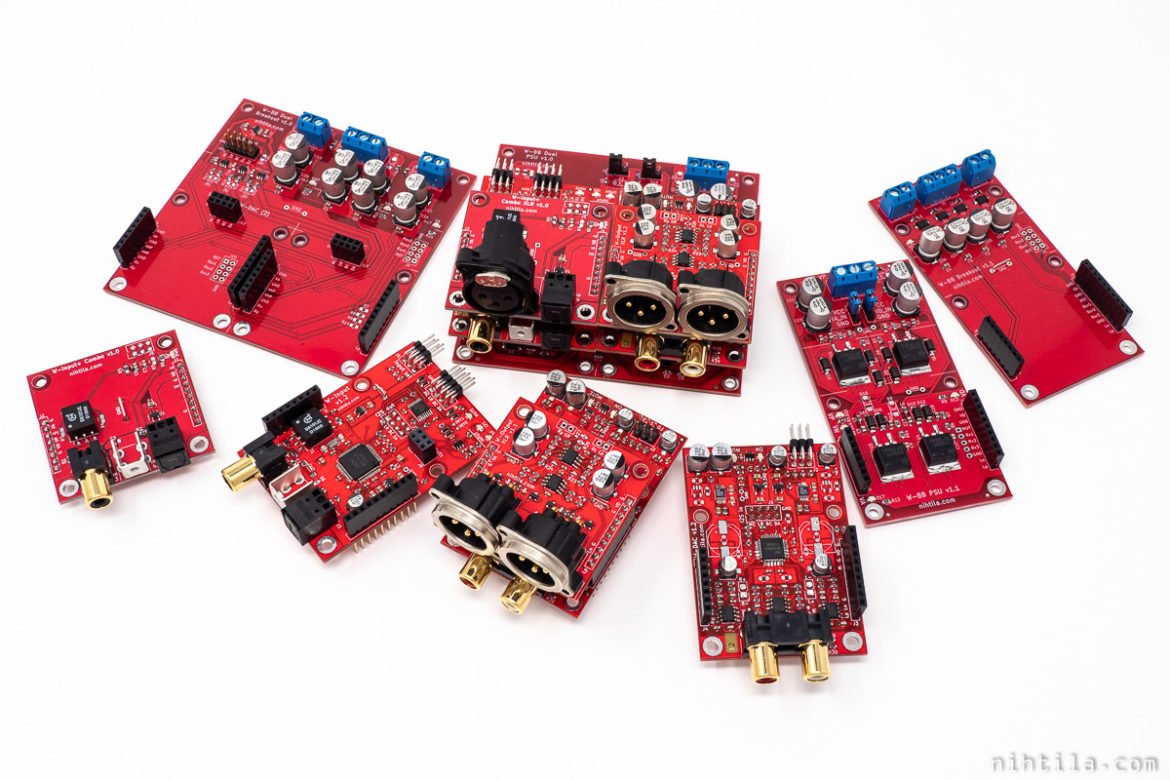Very high performance modular DAC system
- High system level flexibility
- Reusable boards
- Very high performance DACs, up to
- THD+N ratio: -115 dB
- THD ratio: -121 dB
- Dynamic range / SNR: 121 dBA
- Crosstalk: -125 dB, 10 kHz
- 32 bits / 768 kHz DAC (using direct I2S)
- Optional balanced output
- Range of inputs available
- Coaxial and optical S/PDIF
- I2S (for external USB module, for example)
- Expandable with additional S/PDIF or AES/EBU inputs
- Semi-open design: detailed measurements and schematics available
- Assembled boards available
- More boards coming in the future

Here is a brief description of the system with lots of photos. Find more information on the boards by clicking captions or photos for corresponding posts. They contain more detailed information including schematics and comprehensive measurement results.
Modular DAC system design
If we think of a complete DAC with all blocks that are typically involved, we can roughly divide it into following blocks:
- Power supply
- Inputs, input circuits, and input selector
- DAC chip with necessary external components
- Output stage
We can of course continue breaking these down into smaller blocks. However, some parts are inseparable. For example, while there is always a main power supply circuit individual blocks often have local power supplies as well.
While some blocks are trickier to separate, Wee DAC approach is to offer these blocks on individual boards. This offers several advantages:
- Possibility to swap some parts in the system without changing everything
- Reuse boards in other Wee DAC systems or completely different systems
- Expand system capabilities later on, for example add more inputs or add balanced outputs
Nothing comes without tradeoffs so there are always drawbacks as well
- Increased complexity
- System understanding to choose correct boards (or just ask!)
- Slightly increased cost
- Although must say that in this case it can be an advantage as well due to reusability of boards in other projects
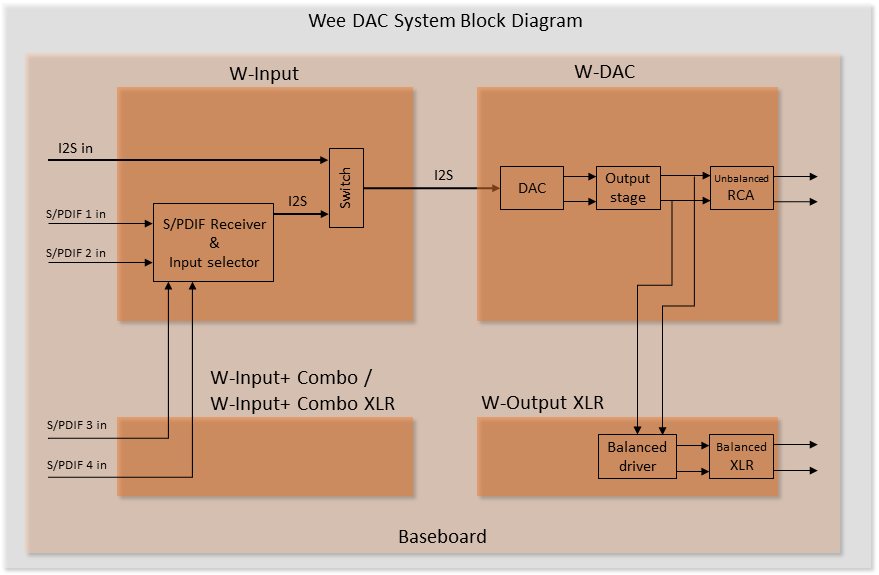
Notes on naming: Wee DAC refers to this whole system of DAC board, S/PDIF input board and other addon boards, while W-DAC refers to the DAC board only. All board names in this system have the initial W in the name.
I2C-controlled boards
Added 28.12.2020
New S-versions (S for software) of W-Input and W-DAC, and a matching W-Output XLR Mute, were introduced and below is an updated block diagram sketch using these slightly more complicated boards.
Note that W-Input S and W-DAC require I2C control from a host that can be Arduino, RPi, or any sort of microcontroller. I do not provide the control software/firmware (at least for now). However, if you have ever done anything similar it is very simple, and there are a few lines of pseudo-code on W-Input S and W-DAC S pages and that is really all you need to get started.
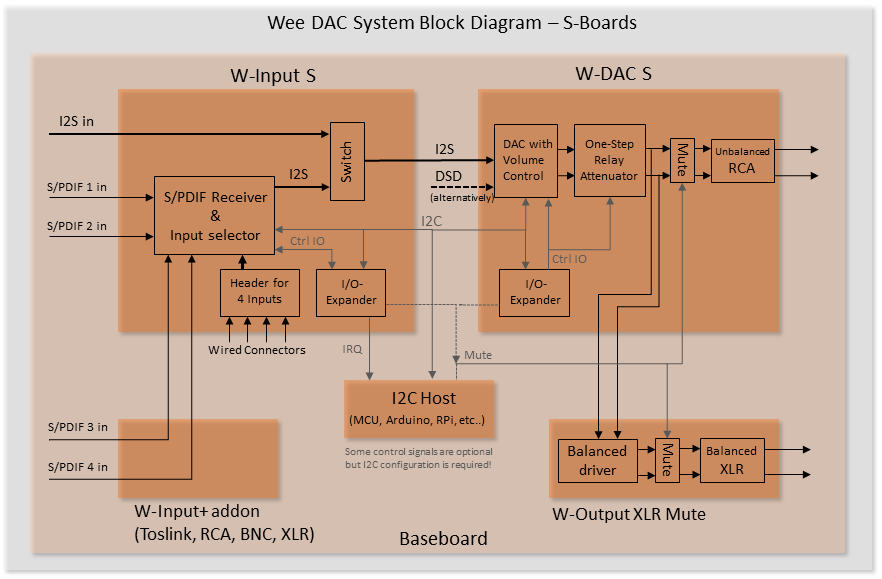
The biggest advantage of this I2C controlled system is ability to use volume control in the DAC, and this along with output hard mute makes it all that is needed to build a very high performance DAC-preamplifier.
Board comparison
The amount of board choices can be overwhelming so hopefully these tables help. If in doubt, please ask.
W-DAC comparison table
| W-DAC 4490 | W-DAC 4493 | W-DAC S 4493 | |
| Control | Not needed (filter selection by jumper) | Not needed (filter selection by jumper) | I2C |
| Supplies | +5 VD, +7 VA, +15 VA, -15 VA | +5 VD, +15 VA, -15 VA | +5 VD, +15 VA, -15 VA |
| DAC IC | AK4490EQ | AK4493EQ | AK4493EQ |
| Opamps | LM4562 | LM4562 | LM4562 |
| Max bit depth / sample rate (PCM signal) | 32 bits / 768 kHz | 32 bits / 768 kHz | 32 bits / 768 kHz |
| DR, A-weighted (typ.) | 119 dB | 121 dB | 121 dB |
| THD+N 997 Hz (sweet spot, typ.) | -108 dB (-5 dBFS) | -115 dB (-1 dBFS) | -115 dB (-1 dBFS) |
| THD 997 Hz (sweet spot, typ.) | -115 dB (-10 dBFS) | -121 dB (-2 dBFS) | -121 dB (-2 dBFS) |
| Digital filters | 5 | 6 | 6 |
| Input (Slave) | I2S | I2S | PCM (I2S, LJ, RJ, TDM) or DSD |
| DSD support | No | No | Up to DSD512 |
| Output mute relay | No | No | Yes |
| Output relay attenuation | No | No | Yes, 1-step -8 dB |
All DACs share common output level of 2 Vrms (6 dBV) and size is the same 70x50mm. See more information on relevant pages.
W-Input comparison table
| W-Input | W-Input S | |
| Control | 3-bit binary input for input selection | I2C |
| Supplies | +5 VD | +5 VD |
| Receiver IC | AK4115VQ | AK4115VQ |
| Max bit depth / sample rate (S/PDIF) | 24 bits / 192 kHz | 24 bits / 192 kHz |
| I2S passthrough (any bit depth / sample rate) | Yes | Yes |
| Inputs, onboard | 2 (RCA and Toslink) | 2 (RCA and Toslink) |
| Max external inputs (on top of onboard) | 2 | 6 |
| Output (Master) | I2S | PCM (I2S, LJ, RJ) and S/PDIF |
There is no USB on input boards but I2S passthrough can be used for USB to I2S modules.
W-DAC 4493 – Very high performance compact DAC

- Superb performance:
- THD+N ratio: -115 dB (1 kHz -1 dBFS)
- THD ratio: -121 dB (1 kHz, -2 dBFS)
- Dynamic range / SNR: 121 dBA
- Crosstalk: -125 dB, 10 kHz
- Comprehensive measurement data available
- Unbalanced RCA, 2 V output level
- Balanced addon available
- I2S input, supports up to 32 bits and 768 kHz sample rate
- 6 digital filters selectable with jumper links
- AK4493EQ DAC, LM4562 opamps, LT3042 regulators
- Compact size at 70 mm x 50 mm
W-DAC 4490 – Very high performance compact DAC
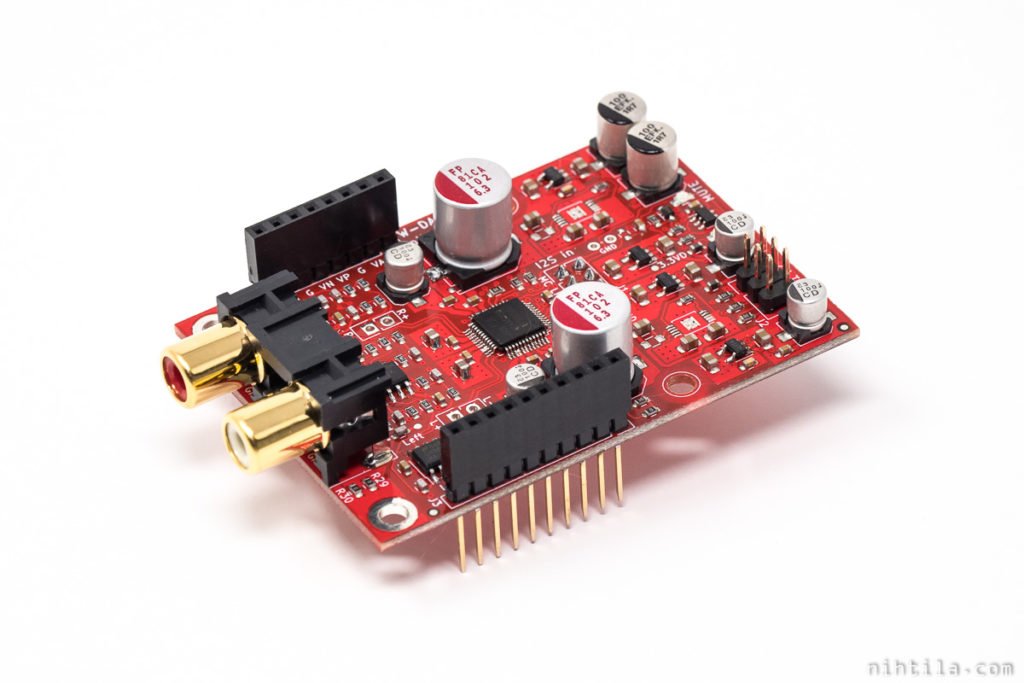
- Very high performance
- THD+N ratio: -108 dB (1 kHz -5 dBFS)
- THD ratio: -115 dB (1 kHz, -10 dBFS)
- Dynamic range / SNR: 119 dBA
- Crosstalk: -125 dB, 10 kHz
- Comprehensive measurement data available
- Unbalanced RCA, 2 V output level
- Balanced addon available
- I2S input, supports up to 32 bits and 768 kHz sample rate
- 5 digital filters selectable with jumper links
- AK4490EQ DAC, LM4562 opamps
- Compact size at 70 mm x 50 mm
W-DAC S 4493 – I2C controlled version of W-DAC 4493
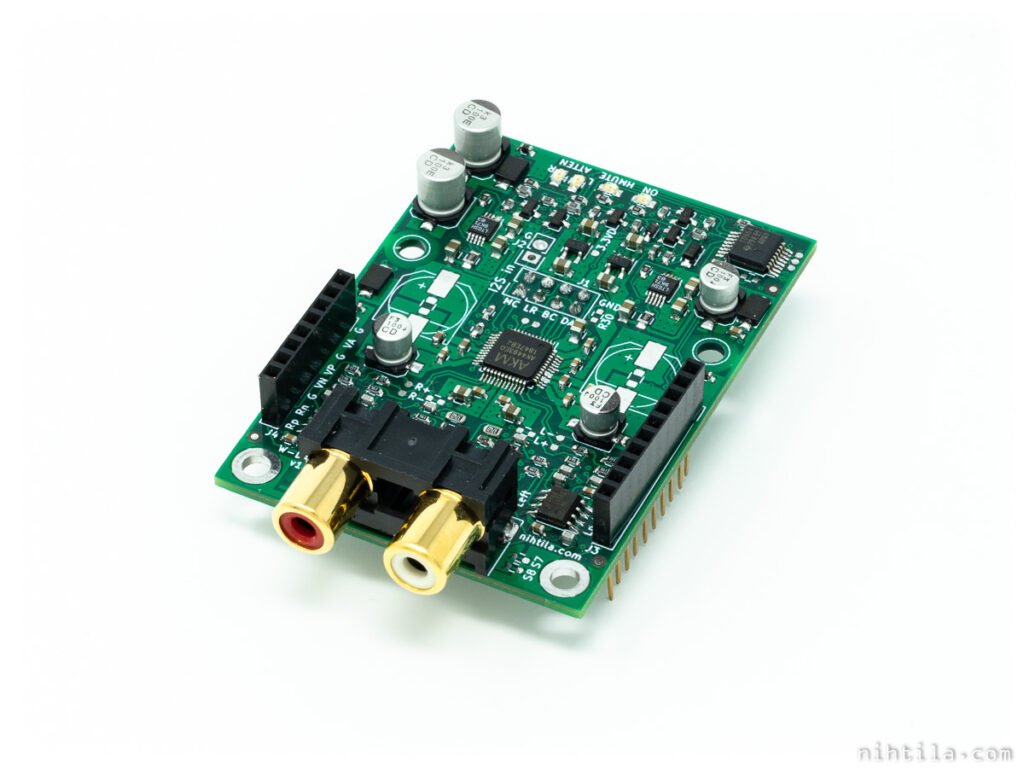
This board is a software-controlled version of W-DAC 4493, plus a few tricks added to improve it’s practical performance and usability especially in preamplifier applications. Another new feature not possible in HW-controlled version is DSD support. Here are the new features summarised:
- I2C-controlled – requires a microcontroller (e.g. Arduino) or any I2C host for control firmware
- Control firmware is not provided but there are code snippets on how to get it up and running
- Note that I2C control is required to get any audio out of the DAC
- DSD support
- Automatic hardware output mute
- Very useful in preamp application to avoid pops at power-up and shutdown
- Hybrid volume control – digital volume and one-step relay attenuation
- Greatly improves performance in practical volume levels in preamp use
W-Input – Compact digital input board

- Flexible digital input board combines I2S input and S/PDIF inputs
- One I2S input / passthrough
- One Toslink S/PDIF input
- One isolated coaxial S/PDIF input
- More inputs (Toslink / Coax / AES/EBU) can be added with addon board
- I2S output (up to 192 kHz / 24-bit from S/PDIF)
- High performance to match with high performance DACs
- AK4115VQ S/PDIF receiver
- Compact size at 70 mm x 50 mm
W-Input S – I2C controlled version of W-Input
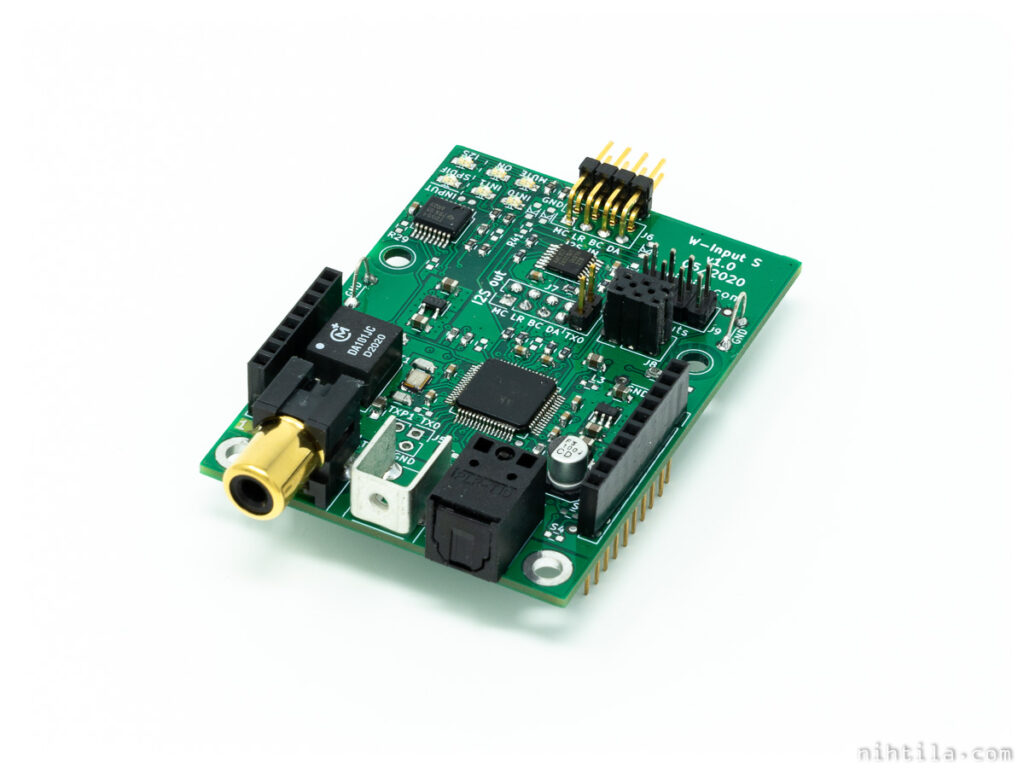
This is a software-controlled version of W-Input compact S/PDIF receiver board. It offers basically the same features but requires control and setup via I2C bus. In addition, up to 8 inputs can be used.
Wee DAC addon boards
There are three addon boards for Wee DAC to expand feature set:
- Balanced XLR output for W-DAC
- Extra Coaxial and Toslink S/PDIF inputs for W-Input
- Extra AES/EBU XLR and Toslink S/PDIF inputs for W-Input
W-Output XLR

Adds balanced output to W-DAC.
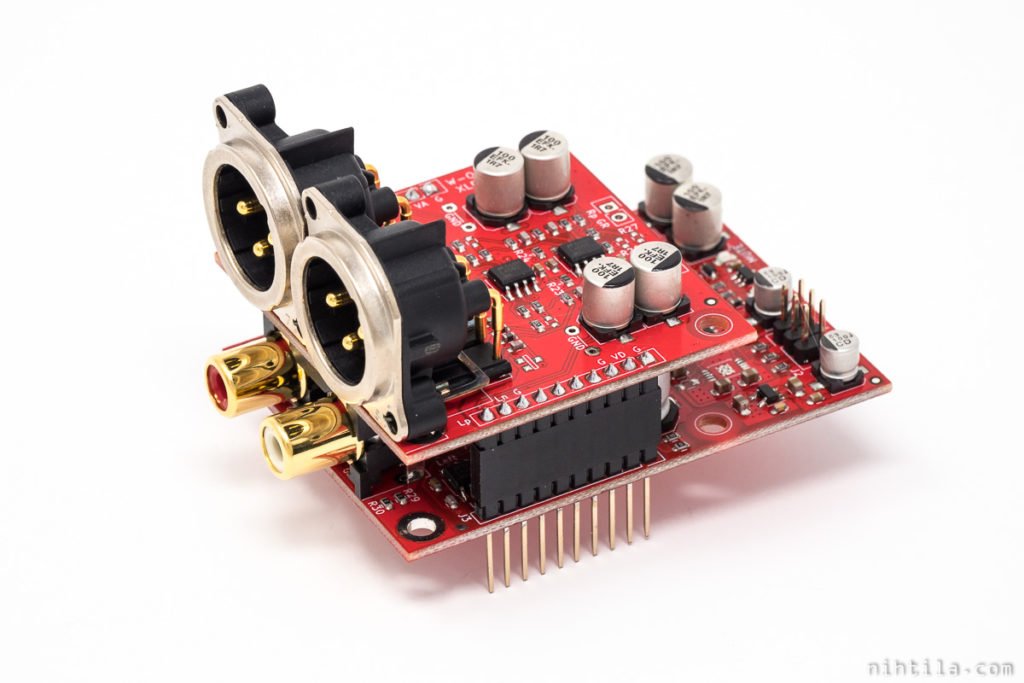
W-Output XLR Mute
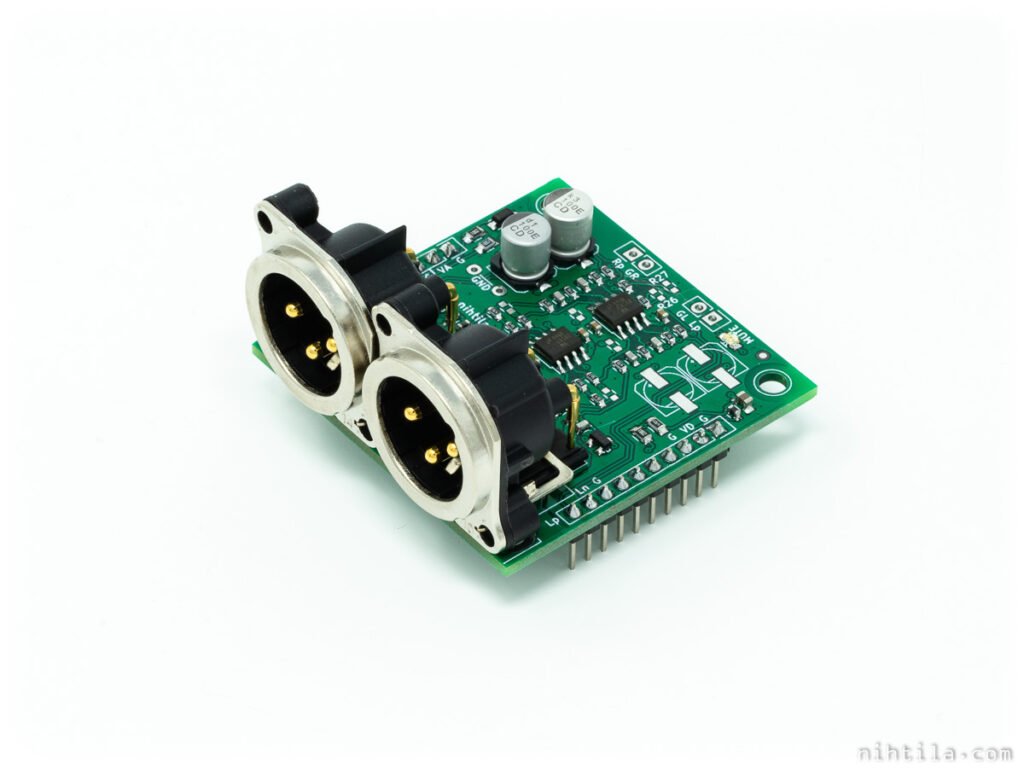
The same as W-Output XLR but has output mute relay to match W-DAC S.
W-Input+ Combo
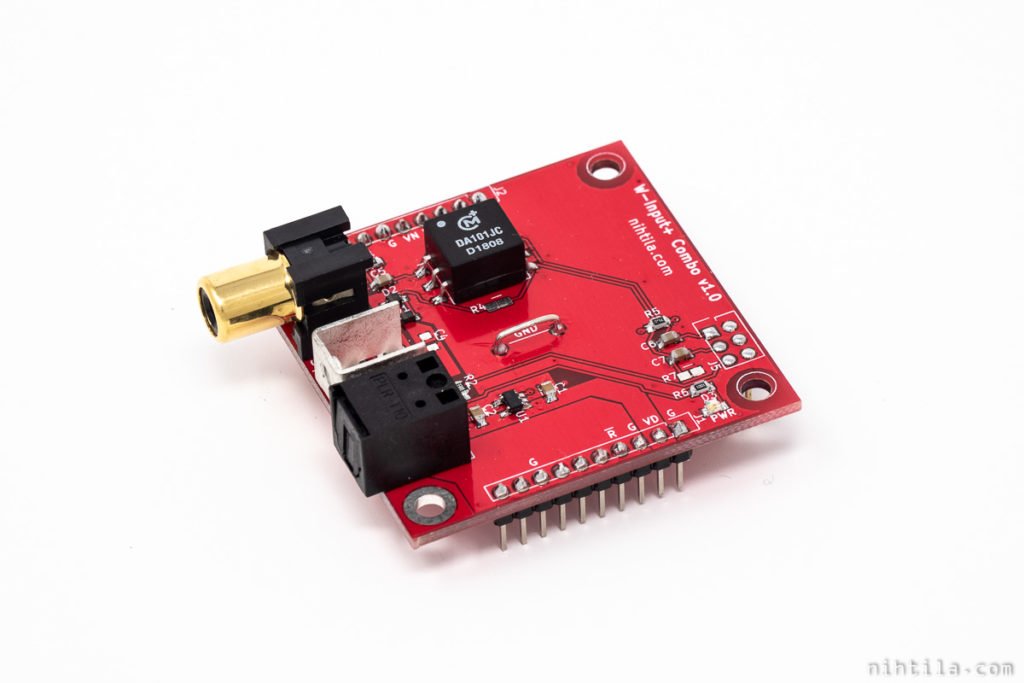
Adds extra Coaxial S/PDIF and Optical Toslink inputs to W-Input.
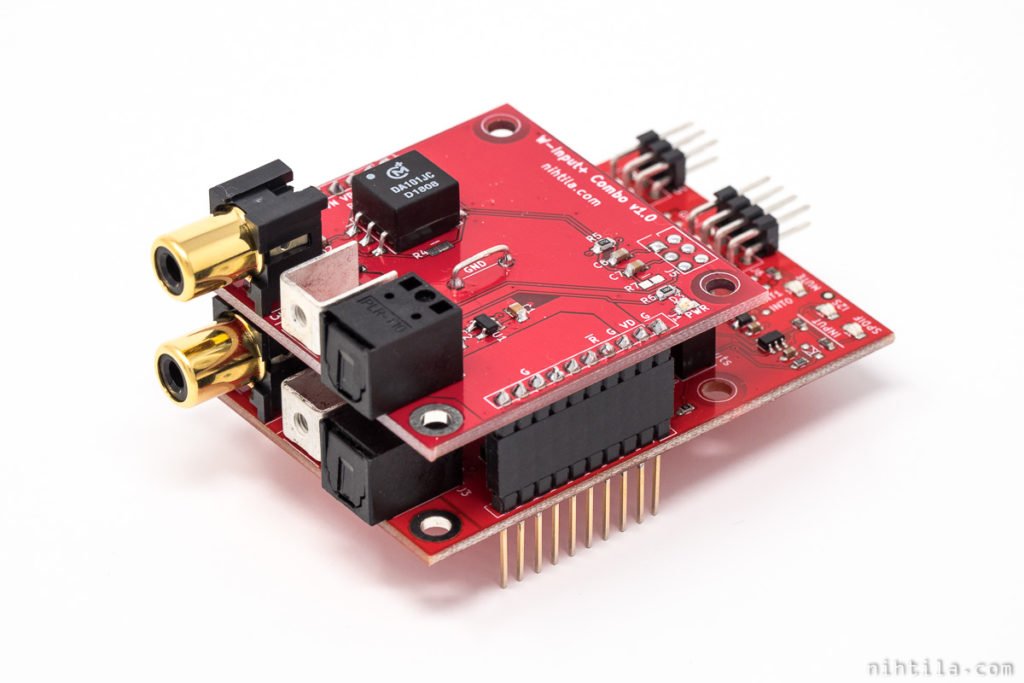
W-Input+ Combo XLR
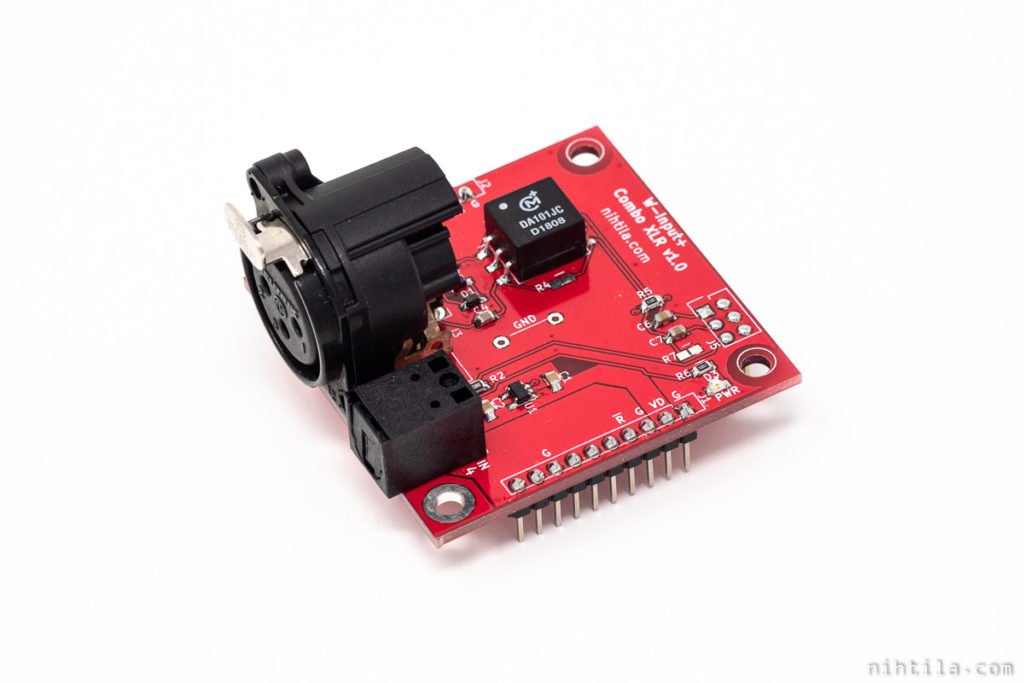
Adds extra Balanced AES/EBU and Optical Toslink inputs to W-Input.
W-Input+ Combo BNC
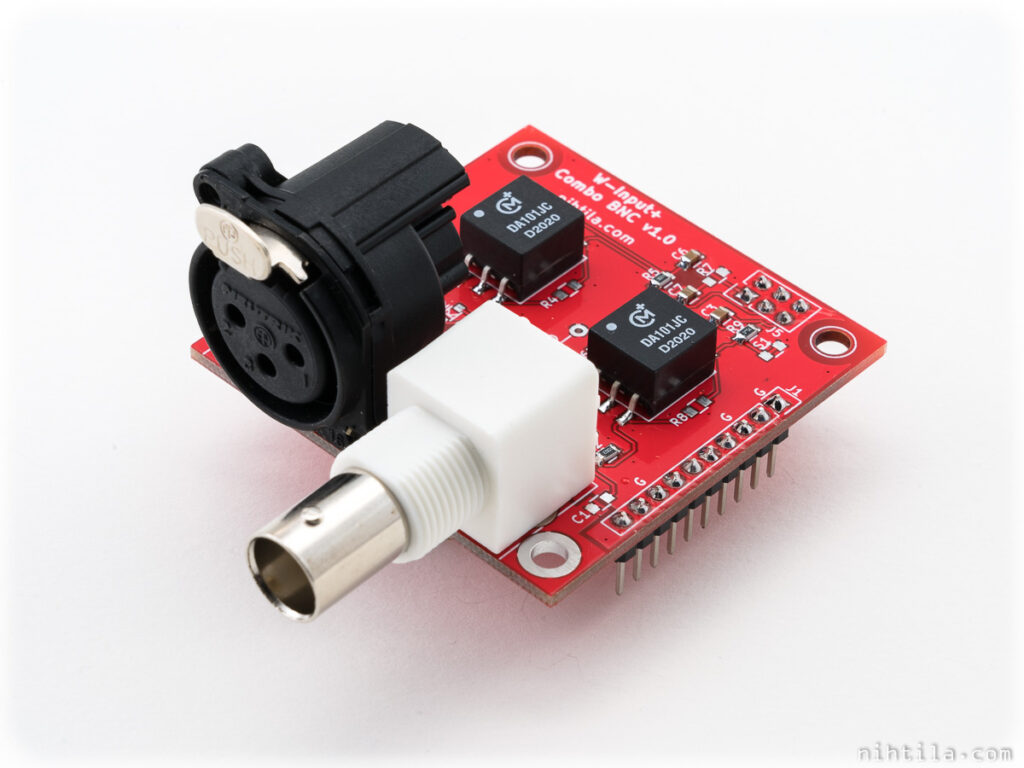
Wee DAC baseboards
Wee DAC is a flexible modular system and there are several different baseboards offering numerous configuration options depending on the system requirements:
- DAC with S/PDIF inputs or only I2S-input
- Two channel DAC or four channel (2x stereo) I2S DAC
- Number of S/PDIF inputs
- Vertical or horizontal stack of boards
There are two types of baseboards:
- Breakout board for external voltage regulators
- PSU board including voltage regulators
Then both options are available for vertical or horizontal (dual) stack.
W-BB Breakout
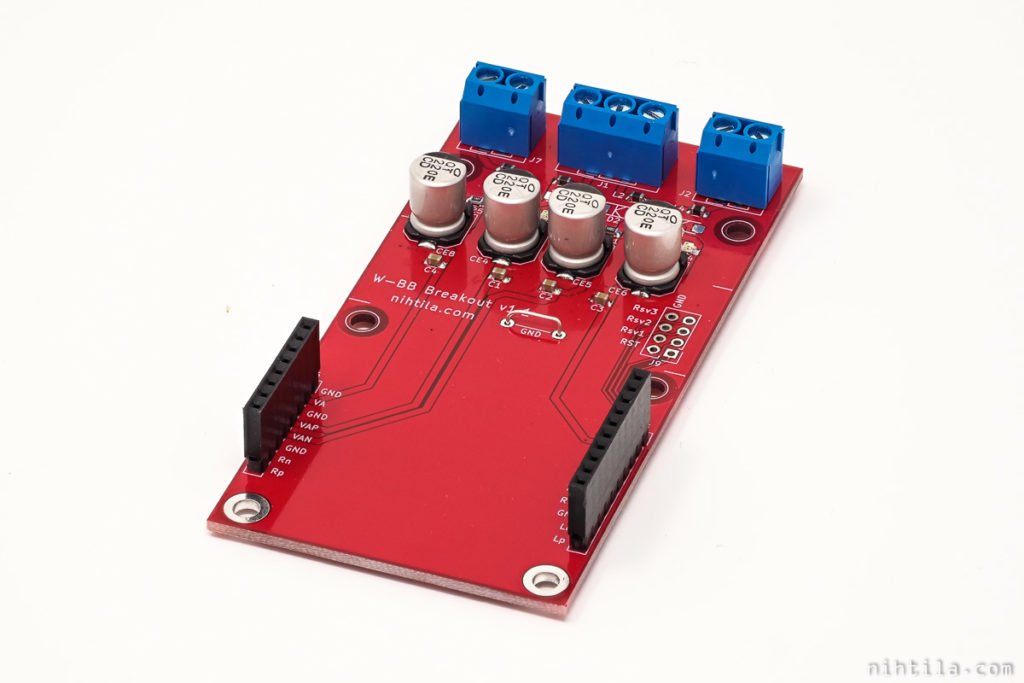
W-BB PSU
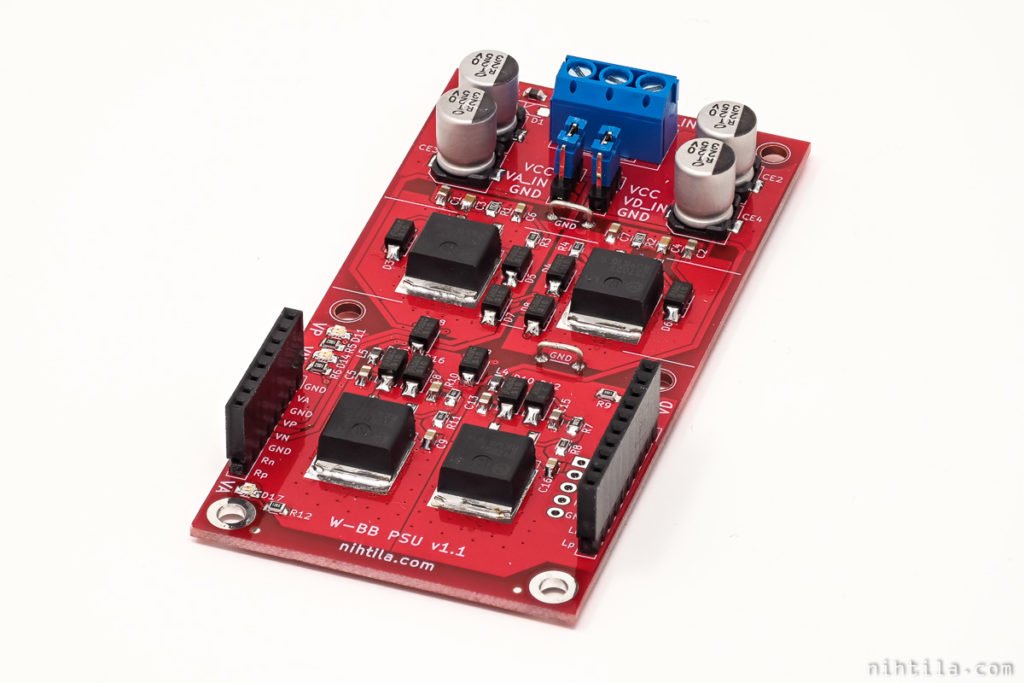
Note that current W-BB PSU has three regulator circuits and voltage outputs available; VA supply components are not populated due to W-DAC 4493 not using VA supply.
W-BB Dual Breakout

W-BB Dual PSU

Note that current W-BB Dual PSU has three regulator circuits and voltage outputs available; VA supply components are not populated due to W-DAC 4493 not using VA supply.
Configuration examples
With flexibility comes complexity so here are photos showing various configuration options. Baseboards are the final elements to create required system and there are numerous options.
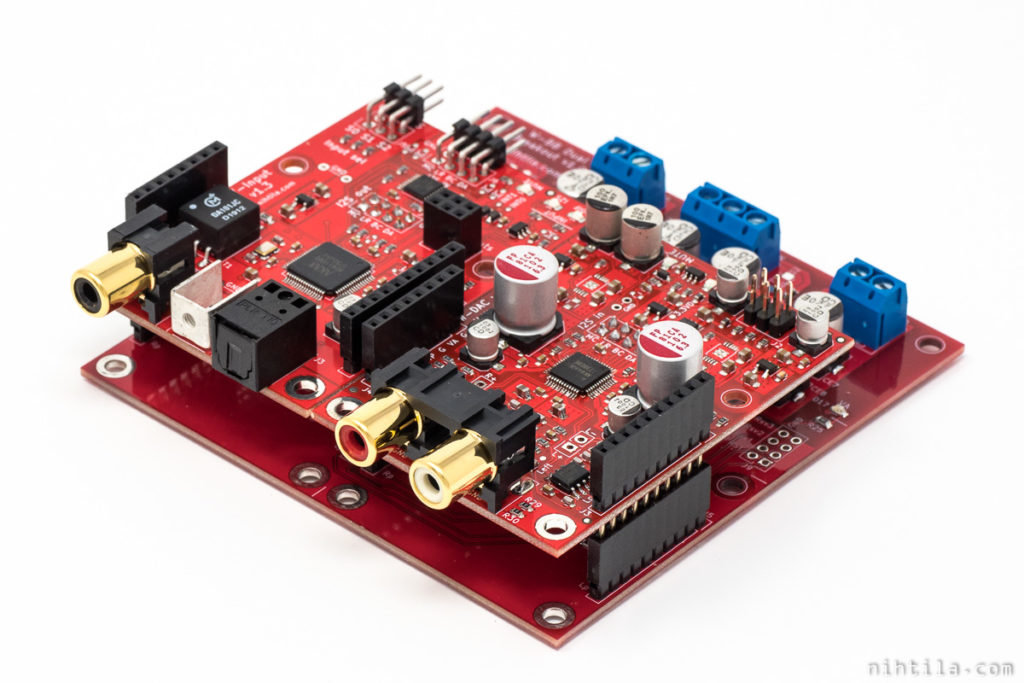
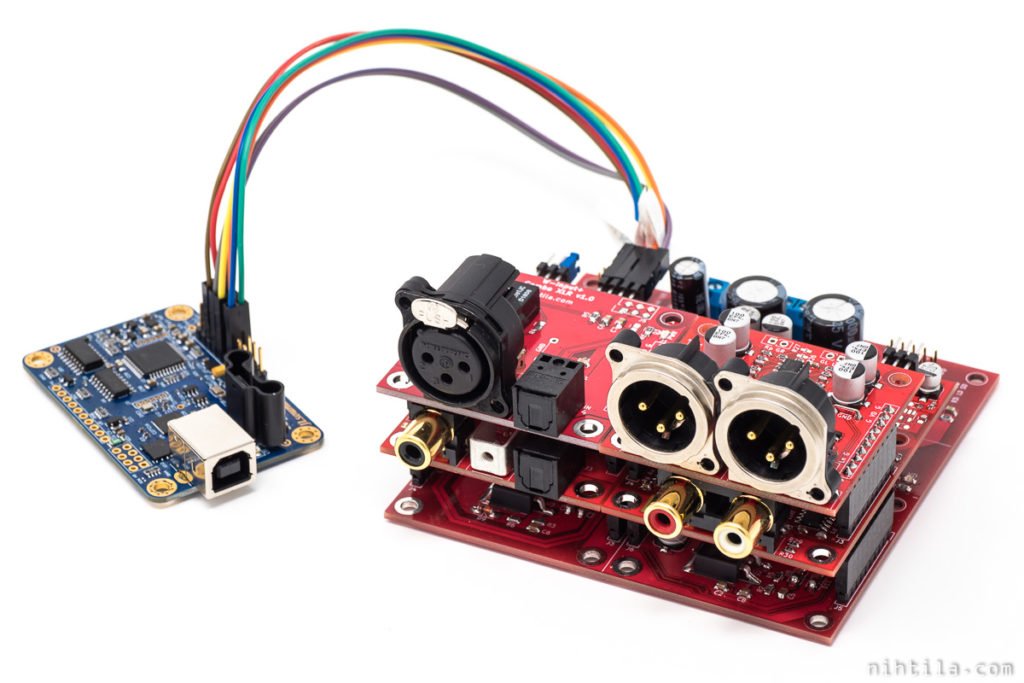
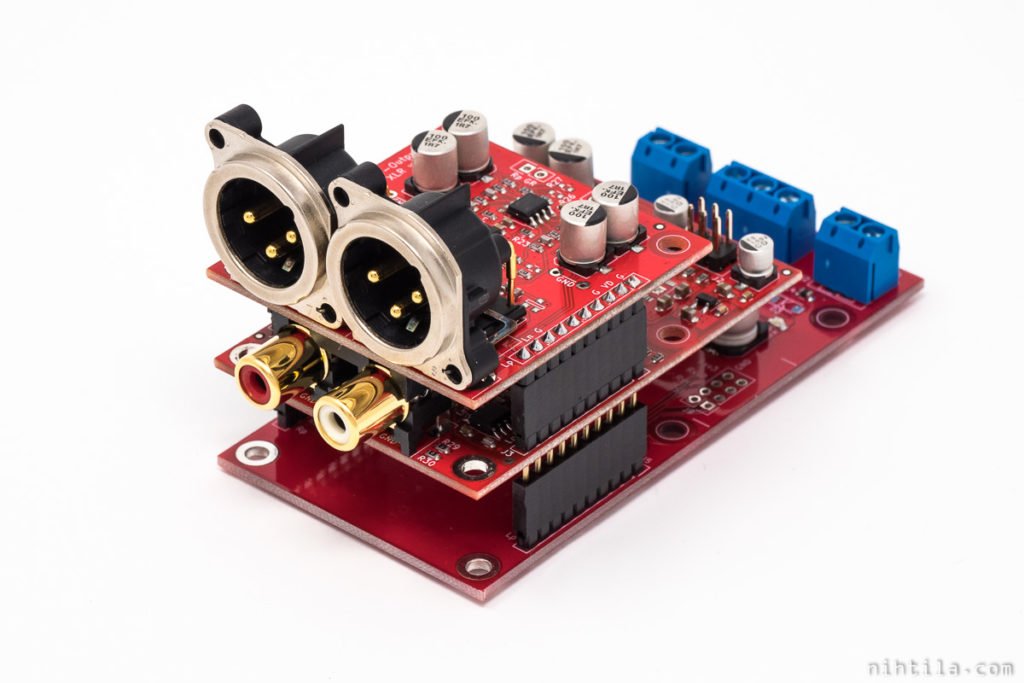
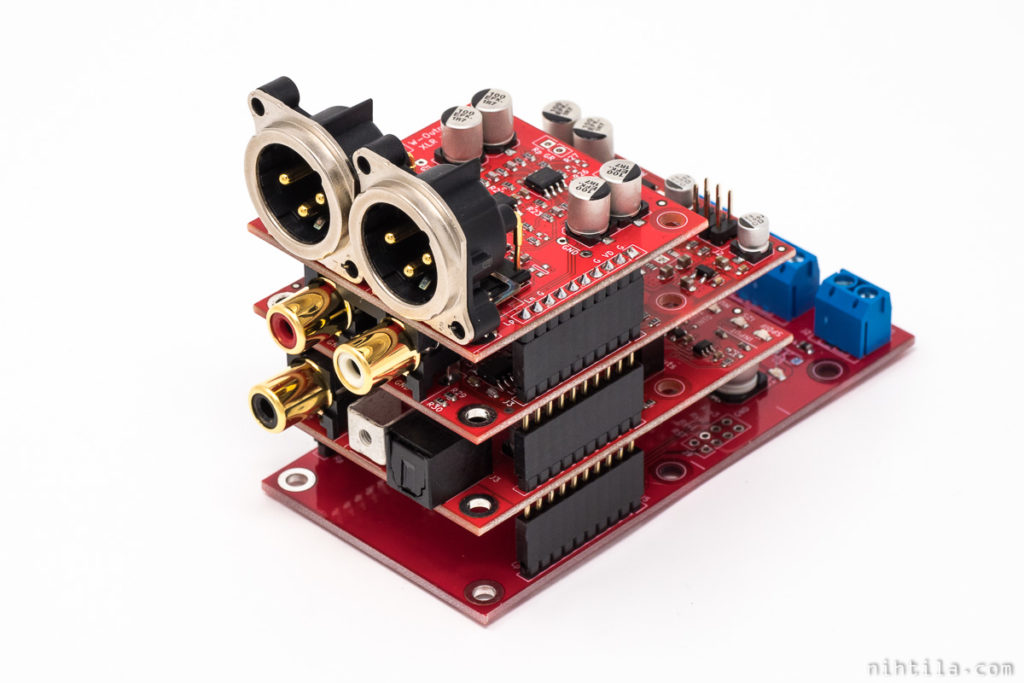
Also 4-channel I2S DAC is possible:
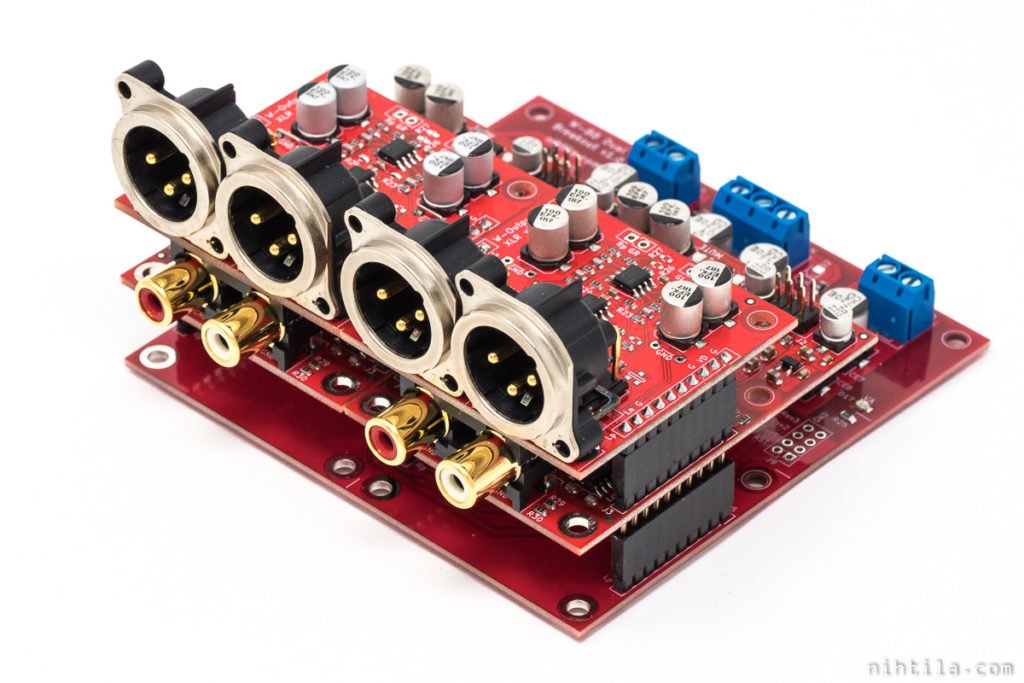
Stacking these boards obviously makes quite high stack and may not fit in a 80mm high enclosure, for example. There are a few places to make it lower though, still keeping the stack:
- Cut W-Input pinheaders a bit shorter to bring it closer to the baseboard
- Cut W-DAC pinheaders and RCA pins slightly; doesn’t give as much base as cutting W-Input but a little
- Solder W-Input directly on the baseboard; cannot be removed anymore but this can give 5-8mm of space, and DAC can still be detached
- Wire out XLR connectors; placing XLRs on rear panel next to the stack frees at least 15mm and is still easier to do than wiring a complete board out of the stack
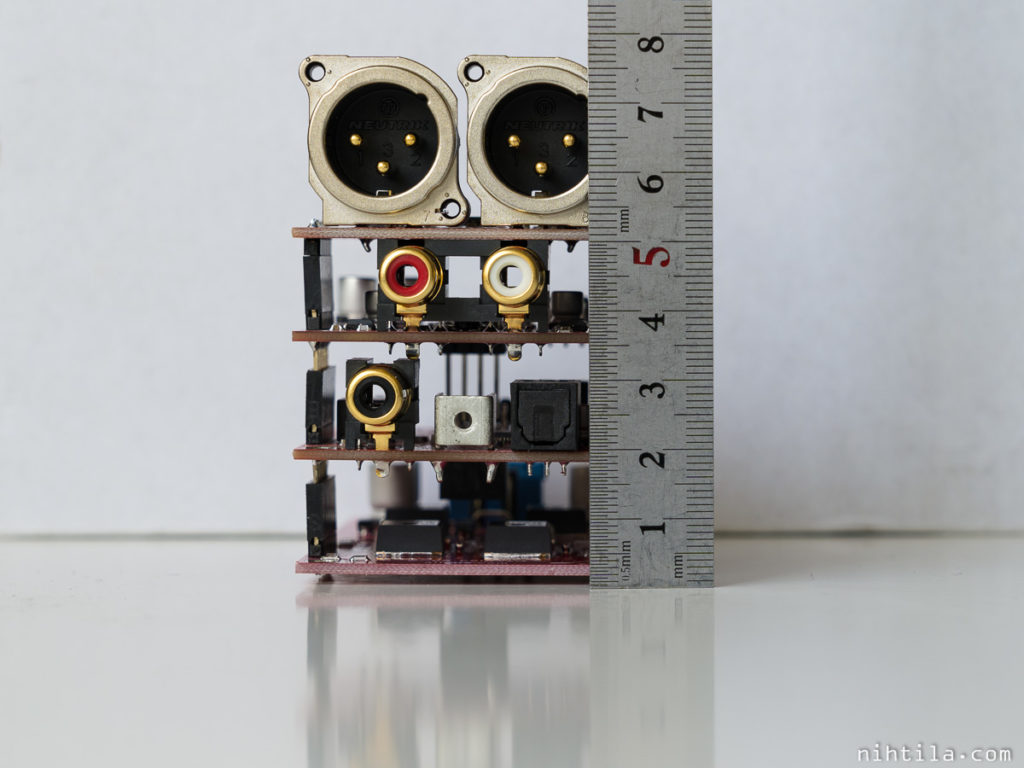
Design philosophy
Here is a bit longer train of thought behind Wee DAC.
Modularity has obviously been one of the key aspects when designing this system. That gives great flexibility and makes it possible to swap components without changing everything, and expand the system capabilities. Hopefully this also lengthens the lifespan of the system. Pros and cons of modularity were already listed in the beginning.
Form factor
Another key feature, as the name implies, is small size. Originally the footprint was supposed to be 50mm x 50mm but this became too restricting when adding more features. Now the board sizes are:
- W-DAC and W-Input: 70mm x 50mm
- W-Output XLR, W-Input Combo, and W-Input Combo XLR: 50mm x 50mm
- Single baseboards: 100mm x 50mm
- Dual baseboards: 100mm x 100mm
Small size gives neat compact design and it also offers technical benefits. Parasitics are smaller when physical size is smaller, usually giving higher performance and also making it possible to use higher frequencies and bandwidths. Besides performance, cost is another thing driving electronics continuously smaller.
Technical aspects
My design philosophy is very engineer-like; and I am an engineer after all. I choose solid technical foundations over exotic components and approach. This usually goes without saying – except in audio electronics. I see that when basics are done right, then there may be room for experimentation as well. There are many approaches in DIY audio; some experiment without great technical understanding or don’t care about that, some work out from fundamental understanding and measurements. I’m not saying any approach is wrong but if the figure of merit is very subjective, it’s practically impossible to say if a design is good or bad. The designer usually tend to say it sounds awesome no matter what. Audio is never objective but I have tried to take rather objective and technical point of view.
Regarding my audio system philosophy, when it comes to building an audio setup, I prefer choosing the tonal preferences at the end of the chain, not in the source but speakers or headphones. I like my source and amplification technically solid without exotics – neutral to say.
PCB and local regulations
Going deeper into details, we electronics engineers know that PCB is one of the most important components of any design. Making mixed signal boards, 2 layers are way too restricting in terms of good PCB design. Going large in size may overcome some obstacles but is not optimal in other ways. However, especially when boards are compact like mine, 4 layers is a must. Simpler boards like the Input addons and Baseboards are 2-layer designs.
Another key thing, also tied to PCB design, is local voltage regulators. All this design has been a learning process and this became very clear when testing the first board revisions; performance was not great without local on-board regulators. Therefore, Baseboards with power supply only work as pre-regulator circuit. It is also worth mentioning that if you use one of the Breakout Baseboards, I don’t think it’s worth spending money on fancy power supply boards as after all it will be all about the local regulators – unless the supply quality is truly awful.
DAC output stage
DAC output circuit is based on opamps. This is not to everyone’s liking but follows my philosophy of having solid technical foundations. It is very difficult, time-consuming, space-consuming, and expensive to make discrete circuits better than good opamps.
Again, allowing sub-optimal circuit to add maybe certain type of distortion to slightly colour the sound may sound awesome to someone’s ears but may not work in every system. And the same goes for every component in an audio system so it really comes down to your own philosophy and preferences.
All-important measurements
This is something many audio makers neglect of not being important as you ‘only need to trust your ears’. Of course there is also the practical point that in order to measure very high performance circuits, one needs either extremely expensive commercial measurement kit or a complex, dedicated and again superb quality DIY measurement kit, which is possible but again lack of reference and calibration may be an issue.
I am in the lucky position that I have access to a state of the art audio measurement kit (APx 555) through my 9-to-5 job. Therefore, I have been privileged to really fine-tune the technical performance by running extensive measurements. And I am not hiding these measurement results.
Semi-commercial design
I have been designing audio hardware for myself as a hobby for a while. I have been selling bare PCBs to someone who wants but there has not really been thoughts of trying selling anything before this.
At some point of this design process I set a goal for myself to get the design to the point where it is finalised well enough that it could be actually sold. This meant that for the first time I actually needed to iron out all bugs and wire mods and get the design to be robust enough.
Semi-open hardware
Although this is my first semi-commercial project, I still want to keep it semi-open as well. In all these years I have learned a lot by looking at other people’s schematics and reading their design descriptions. Therefore, to give something back I will publish the schematics but not the gerbers to keep ‘half’ of the design to myself.
Wee DAC development
I have written a few posts along the way when developing Wee DAC boards. These posts can be found here and starting from the oldest posts.
Wee DAC roadmap
There has been ideas of making software-controlled versions of W-Input and W-DAC. That would mean a microcontroller with software, or a connector to Arduino or similar. Besides added functionality with access to device registers, the most significant new feature would be the ability to use DACs internal volume control, making Wee DAC effectively a preamplifier instead of just DAC.
I probably want to try different DACs as well but there are no detailed plans at the moment. I have used TI PCM179x DACs before so that would be quick to make, but I’d also be keen to try Wolfson/Cirrus DACs.
One completely new board planned for Wee DAC system is a switching power supply that can generate all required supplies ±15VA, 7.2VA, and 5VD from a single input in an efficient manner. This is relatively new to me and requires some time to design.
Feel free to contact if you have suggestions what I should do.
Version history
This page version history
- 05.11.2019 Initial version
- 29.2.2020 Added W-DAC 4493
- 11.4.2020 Added photo and paragraph about stack height
- 28-29.12.2020 Added W-Input S, W-DAC S, W-Output XLR Mute, and comparison tables
- 16.2.2021 Added notes that current W-BB PSU and Dual PSU do not have VA supply populated
See version history of boards on corresponding pages.
Wee DAC boards are available to buy.
